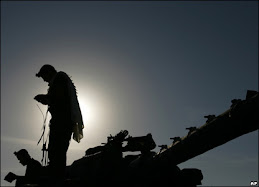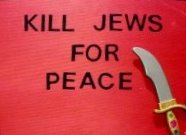Masada Will Not Fall Again!

According to reports, President Bush is shying away from visiting the Western Wall in Jerusalem, when he is in Israel for its 60th Yom HaAtzmaut, Independence Day. The Western Walll, the only remaining defensive wall of the First and Second Temples, was deemed too controversial for Bush.
What is it that is so controversial? The Western Wall, since Jewish prayer on its holiest site, the Temple Mount, is severely restricted, has been the focal point of Jewish worship during the most recent return to Zion. Jews have worshipped there since the destruction of the Second Temple. It was off-limits to Jews under Jordanian rule following the 1949 armistice and was liberated in the 1967 Six Day War. This is where the famous picture of Israeli paratroopers looking up at the Wall in awe comes from.
Muslims have recently been staking a claim not only to the Temple Mount, but to the Western Wall as well. They call it Al-Burak and say the religion's founder, Mohammad, tied his horse there during a midnight journey that took him to "the farthest mosque" - which they say is a reference to the Jerusalem mosque later given that name. However, such a claim is extremely weak compared to the millenia of unbroken Jewish worship on the Temple Mount and later the Western Wall. The Qur'an's Night Journey was only associated with Jerusalem decades after the Mosque of Omar was built. The Mosques on the Mount are inscribed with beautiful Arabic caligraphy with many verses from the Qur'an and yet the Night Journey is conspicuously missing.
The Tomb of the Patriarchs, Mearat HaMachpela, in Hevron, is also mentionned explicitly as being too controversial for Bush to visit. He would certainly not want to upset the Arabs by giving the impression that the Tomb of the founders of the Jewish Nation, of Avraham, Yitzhak and Yaakov, and legal inheritors of that parcel of land, has any connection to Jews. Hevron is the second holiest Jewish site and a hallowed place of prayer beginning with Calev, who prayed there during his touring of the Land, that he should not fall into the conspiracy of the Spies. Under Ottoman rule, Jews were not allowed to pray past the 7th step leading to the Tomb. Certainly, such a thing would be too controversial and offensive to Arab sensibilities.
Instead, Bush has opted to visit the fortress of Masada, where one thousand Jews chose to commit suicide rather than fall into the hands of the Romans.
According to the Jewish Virtual Library:
The only written source about Masada is Josephus Flavius’ The Jewish War. Born Joseph ben Matityahu of a priestly family, he was a young leader at the outbreak of the Great Jewish Rebellion against Rome (66 CE) when he was appointed governor of Galilee. He managed to survive the suicide pact of the last defenders of Jodfat and surrendered to Vespasian (who shortly thereafter was proclaimed emperor) – events he described in detail. Calling himself Josephus Flavius, he became a Roman citizen and a successful historian. Moral judgment aside, his accounts have been proved largely accurate.
According to Josephus Flavius, Herod the Great built the fortress of Masada between 37 and 31 BCE. Herod, an Idumean, had been made King of Judea by his Roman overlords and was hated by his Jewish subjects. Herod, the master builder, “furnished this fortress as a refuge for himself.” It included a casemate wall around the plateau, storehouses, large cisterns ingeniously filled with rainwater, barracks, palaces and an armory.
Some 75 years after Herod’s death, at the beginning of the Revolt of the Jews against the Romans in 66 CE, a group of Jewish rebels overcame the Roman garrison of Masada. After the fall of Jerusalem and the destruction of the Temple (70 CE) they were joined by zealots and their families who had fled from Jerusalem. With Masada as their base, they raided and harassed the Romans for two years. Then, in 73 CE, the Roman governor Flavius Silva marched against Masada with the Tenth Legion, auxiliary units and thousands of Jewish prisoners-of-war. The Romans established camps at the base of Masada, laid siege to it and built a circumvallation wall. They then constructed a rampart of thousands of tons of stones and beaten earth against the western approaches of the fortress and, in the spring of the year 74 CE, moved a battering ram up the ramp and breached the wall of the fortress.
Josephus Flavius dramatically recounts the story told him by two surviving women. The defenders – almost one thousand men, women and children – led by Eleazar ben Ya’ir, decided to burn the fortress and end their own lives, rather than be taken alive. “And so met (the Romans) with the multitude of the slain, but could take no pleasure in the fact, though it were done to their enemies. Nor could they do other than wonder at the courage of their resolution, and at the immovable contempt of death which so great a number of them had shown, when they went through with such an action as that was.”
The Zealots cast lots to choose 10 men to kill the remainder. They then chose among themselves the one man who would kill the survivors. That last Jew then killed himself.
It is quite telling that Bush, instead of visiting sites associated with Jewish renewal and connection to Israel, chose to visit a fortress where the Jews took their own lives, determined not to fall into enemy hands. Especially on the heels of Bush's suicidal policies towards the State of Israel, he could not make a more symbolic choice. Hopefully, Bush will learn the lesson of Masada and realize the determination of the Jewish people to be a free nation in our own land. Let him know that Masada will not fall again!
Cross-posted to Goat's Barnyard

























1 comment:
It makes perfect sense when you realize who Bush really is. See
http://devash.superfreeforums.com/
gog-of-magog-vt11.html?highlight=bush
Post a Comment